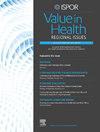Health-Related Quality of Life in Patients With Alzheimer Disease in Malaysia: Evidence from EQ-5D and QOL-AD
IF 1.4
Q3 HEALTH CARE SCIENCES & SERVICES
引用次数: 0
Abstract
Objectives
There were only a few studies that assessed health-related quality of life (HRQoL) of patients with Alzheimer disease (AD) in Malaysia. This cross-sectional study was to investigate the HRQoL scores of patients with AD in Malaysia using 2 HRQoL instruments and to identify predictors of patients’ HRQoL.
Methods
Informal caregivers of patients with AD were recruited in 4 tertiary hospitals during outpatient visits. Patients’ HRQoL was assessed using proxy-rated generic (EQ-5D-5L and EQ-VAS), and disease-specific (Quality-of-life Alzheimer’s Disease [QoL-AD]) assessment instruments were utilized to obtain proxy HRQoL scores of patients with AD from caregivers via structured interviews. The difference between HRQoL scores and other variables was tested using analysis of variance. Pearson correlation test was conducted between the 2 instruments, whereas a multivariable linear regression model was utilized to identify predictors of HRQoL in patients with AD.
Results
The mean EQ-5D-5L index, EQ-VAS, and QoL-AD score of patients with AD were 0.63 ± 0.30, 61.05 ± 20.48, and 26.69 ± 6.83, respectively, via proxy ratings. In terms of correlation, EQ-5D was weakly correlated with QoL-AD (r = 0.36, P < .01). EQ-5D index and QoL-AD score reduced significantly as AD advanced (P < .05). Besides, cognitive decline, presence of behavioral symptoms, female caregiver gender, and nonmarried status were associated with lower patients’ HRQoL in multivariable models with EQ-5D index (P < .05).
Conclusions
Low HRQoL of patients with AD requires attention from healthcare providers and stakeholders in optimal resource allocation and decision making. Such health utility values are useful in future economic evaluations in investigating the cost-effectiveness of new interventions or disease-modifying therapies.
马来西亚阿尔茨海默病患者的健康相关生活质量:来自EQ-5D和QOL-AD的证据
目的评估马来西亚阿尔茨海默病(AD)患者健康相关生活质量(HRQoL)的研究很少。本横断面研究旨在使用2种HRQoL仪器调查马来西亚AD患者的HRQoL评分,并确定患者HRQoL的预测因子。方法在4家三级医院门诊时招募AD患者的正规护理人员。患者的HRQoL使用代理评定的通用(EQ-5D-5L和EQ-VAS)进行评估,疾病特异性(阿尔茨海默病生活质量[QoL-AD])评估工具通过结构化访谈从护理人员处获得AD患者的代理HRQoL评分。采用方差分析对HRQoL评分与其他变量的差异进行检验。两种仪器之间进行Pearson相关性检验,采用多变量线性回归模型确定AD患者HRQoL的预测因素。结果通过代理评分,AD患者的EQ-5D-5L指数、EQ-VAS和QoL-AD评分分别为0.63±0.30、61.05±20.48和26.69±6.83。相关性方面,EQ-5D与QoL-AD呈弱相关(r = 0.36, P <;. 01)。随着AD的进展,EQ-5D指数和QoL-AD评分显著降低(P <;. 05)。此外,在EQ-5D指数多变量模型中,认知能力下降、行为症状的存在、女性照顾者性别和未婚状态与患者HRQoL降低相关(P <;. 05)。结论AD患者HRQoL缓慢需要医疗服务提供者和利益相关方关注资源的优化配置和决策。这种健康效用值在未来调查新干预措施或疾病改善疗法的成本效益的经济评估中是有用的。
本文章由计算机程序翻译,如有差异,请以英文原文为准。
求助全文
约1分钟内获得全文
求助全文
来源期刊

Value in health regional issues
Pharmacology, Toxicology and Pharmaceutics-Pharmacology, Toxicology and Pharmaceutics (miscellaneous)
CiteScore
2.60
自引率
5.00%
发文量
127
 求助内容:
求助内容: 应助结果提醒方式:
应助结果提醒方式:


